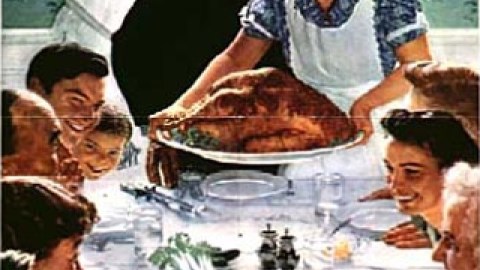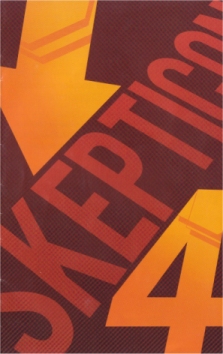The Roots of the Norman Rockwell Thanksgiving

You can have your Martha Stewart Thanksgiving(tm) with the Aleppo pepper-rubbed roast turkey if you wish, but give me the good, old-fashioned, Norman Rockwell version any day. Rockwell’s classic painting (detail above, full picture here) of Grandma lugging in the gigantic bird on a platter as the patriarch awaits his carving duties and the surrounding adults and kids drool in anticipation will always be the quintessential image of Thanksgiving to me. And, yet, when Rockwell painted that iconic scene, it was March 1943—months away from Thanksgiving. The painting, titled Freedom from Want belongs to a series of works Rockwell titled the Four Freedoms after President Franklin D. Roosevelt’s 1941 State of the Union address in which FDR outlined what he saw as the four essential freedoms that all people in the world should enjoy. When you look for the roots of the Norman Rockwell Thanksgiving, you won’t find it in the stuffing or the cranberries (and certainly not in an Aleppo pepper rub)—they’re in the simple idea of human, not just American, freedom.
In that State of the Union address FDR gave seventy years ago, he announced the following:
In the future days, which we seek to make secure, we look forward to a world founded upon four essential human freedoms.
The first is freedom of speech and expression—everywhere in the world.
The second is freedom of every person to worship God in his own way—everywhere in the world.
The third is freedom from want, which, translated into world terms, means economic understandings which will secure to every nation a healthy peacetime life for its inhabitants—everywhere in the world.
The fourth is freedom from fear, which, translated into world terms, means a world-wide reduction of armaments to such a point and in such a thorough fashion that no nation will be in a position to commit an act of physical aggression against any neighbor—anywhere in the world.
That is no vision of a distant millennium. It is a definite basis for a kind of world attainable in our own time and generation. That kind of world is the very antithesis of the so-called “new order” of tyranny which the dictators seek to create with the crash of a bomb.
Spoken in the days before America’s entry into World War II, as the Great Depression still lingered, while we were assisting Britain in their fight, and were coming to the realization that joining the fray was just a matter of time, these words rang out across America and the world. FDR’s idealist, perhaps even naïve streak shines through in his belief that those freedoms were “attainable in our own time and generation” as an antidote to the tyranny of the Axis powers. (This section of the address comes right after a call for higher taxes that sounds like political suicide today.) Freedom from fear is the one we think of from that time—a codicil to Roosevelt’s earlier axiom that “We have nothing to fear but fear itself.” It’s also the one freedom we’ve been striving for in our time, this endless “Age of Terror” and its accompanying wars.
In February and March 1943, The Saturday Evening Post published essays on each of FDR’s Four Freedoms in four consecutive issues, each accompanied by a painting by Norman Rockwell. For Freedom from Fear, Rockwell chose to depict a mother and father tucking their children into bed to sleep the sleep of the innocent and the blissfully unaware of the destructive powers in the world. Freedom of Worship collects a flurry of faces with hands clasped in prayer—a phalanx of free worship in a time when Jews were being annihilated for their faith. A brave soul stands up to speak his mind in his best Mr. Smith Goes to Washington pose to represent Freedom of Speech.
When it came time to depict Freedom from Want, Rockwell chose Thanksgiving as the perfect symbolic moment. Although Thanksgiving can be traced back to the pilgrims in the 1600s, the celebratory date of the fourth Thursday of November was not set by law in America until the end of 1941, the same year as FDR’s “Four Freedoms” speech and just weeks after Pearl Harbor. Before then, the customary date was the last Thursday of November, a move initiated (but not legislated) by President Abraham Lincoln in 1863 in hopes of bringing the nation, torn asunder by the Civil War, literally back to the table together. Before that, the celebratory day varied by state and region. Just as FDR’s idea of freedom from want allied people all around the world, his proclamation of a unified Thanksgiving allied the country in good times and bad.
I love Rockwell’s rendering of the Thanksgiving feast. Three generations circle the food—a nuclear family more rarely seen today in person, but still existing in our hearts and minds in modern permutations. In the lower right corner, a young man looks out at you with an expression saying, “Is this great, or what?” You want to answer him with a smile and nod. Despite the gargantuan gobbler as the focal point of the painting, the real focus is on family and freedom from the want and deprivation that tears families apart and tries the souls of adults and children. The nourishment isn’t just tryptophan-laden protein—it’s the consolation of freedom from the despair of not knowing where your next meal is coming from. As we continue to climb out of our own economic trials—both in American and across the world—it’s important both to give thanks for our own freedom from want and to pray for a similar freedom for all.
[Image:Norman Rockwell. Freedom from Want (detail) from the Four Freedoms series, 1943. (Image source.)]





